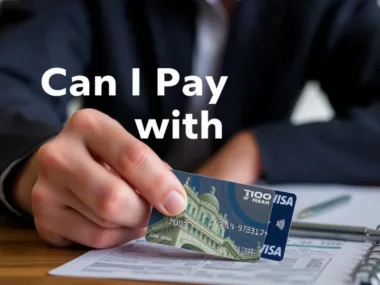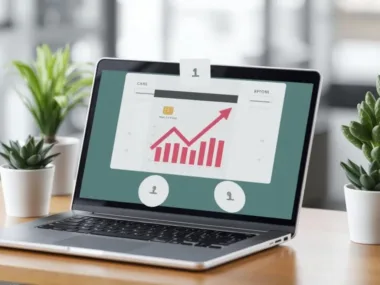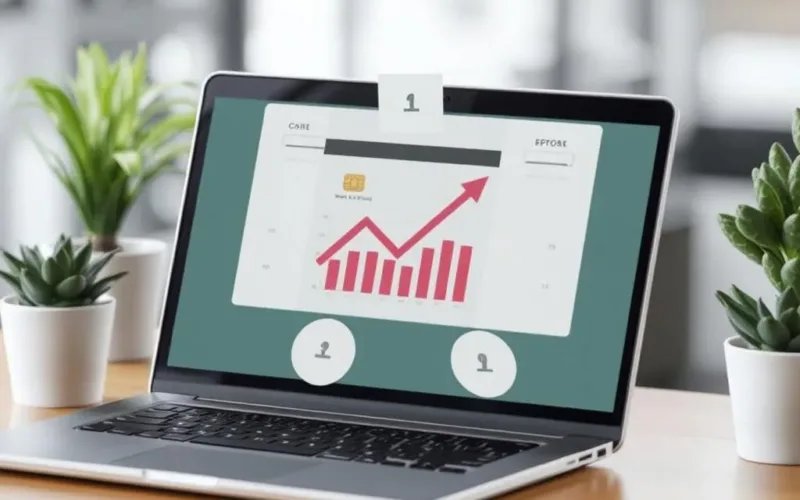Paying taxes with a credit card can offer convenience and potential rewards. This comprehensive guide explores how it works, the fees involved, pros and cons, and practical tips for individuals and businesses in the U.S. Navigate tax season with confidence and make informed payment decisions.
How Can I Pay Tax with a Credit Card: A Comprehensive Guide
Tax season can feel like navigating a maze, but there’s a convenient option you might not have considered: paying your taxes with a credit card. This method offers flexibility, the chance to earn rewards, and a way to manage cash flow, but it also comes with fees and risks that require careful thought. In this comprehensive guide, we’ll explore everything you need to know about paying taxes with a credit card in the U.S., including how it works, the costs involved, the pros and cons, alternatives, and practical tips to make an informed decision. Whether you’re an individual taxpayer or a small business owner, this article will help you decide if this payment method is right for you.
Can You Pay Taxes with a Credit Card?
In the United States, you can pay federal taxes with a credit card through authorized payment processors designated by the Internal Revenue Service (IRS). These processors facilitate secure transactions, allowing you to settle various tax obligations using major credit cards like Visa, Mastercard, Discover, or American Express. The IRS partners with third-party companies to handle these payments, ensuring compliance with federal regulations.
For state and local taxes, the ability to pay with a credit card varies by jurisdiction. Many states and municipalities offer online portals or third-party processors that accept credit card payments, but the availability, fees, and processes differ. For example, some states use the same processors as the IRS, while others have their own systems. To confirm whether your state or local taxes can be paid with a credit card, visit your state’s tax authority website or contact their office directly.
The types of federal taxes you can pay with a credit card include:
- Form 1040 Series: Individual income taxes, including balances due and past-due amounts.
- Form 1040-ES: Estimated taxes for self-employed individuals or those with additional income.
- Form 4868: Payments associated with tax return extensions.
- Business Taxes: Certain business taxes, such as those for sole proprietors or small businesses, can also be paid via credit card.
However, not all federal taxes are eligible, and specific restrictions may apply. For instance, some niche tax types or penalties may require alternative payment methods. Always verify eligibility on the IRS website (IRS.gov).
How to Pay Federal Taxes with a Credit Card
Paying your federal taxes with a credit card is a straightforward process, but it requires careful attention to detail. Here’s a step-by-step guide:
- Determine Your Tax Liability: Calculate the amount you owe or plan to pay, such as your income tax balance, estimated taxes, or extension payment. You’ll need this information to complete the transaction.
- Choose an Authorized Payment Processor: The IRS partners with several third-party processors to handle credit card payments. As of the latest information, these include:
- PayUSAtax (PayUSAtax)
- Pay1040 (Pay1040)
- ACI Payments, Inc. (ACI Payments)
- Visit the Processor’s Website: Navigate to the chosen processor’s website and select the type of tax payment (e.g., income tax, estimated tax).
- Enter Tax Information: Provide details such as your Social Security Number (SSN) or Employer Identification Number (EIN), the tax form number, and the tax period.
- Input Credit Card Details: Enter your credit card information, including the card number, expiration date, and security code, along with the payment amount.
- Review and Confirm: Verify the transaction details, including the convenience fee charged by the processor. Confirm the payment to complete the process.
- Save Confirmation: Keep the confirmation email or receipt for your records, as it serves as proof of payment.
You must know your tax liability or estimated tax amount before initiating the payment, typically determined through tax preparation software or a completed tax return. The IRS website provides links to these processors and detailed instructions to ensure a smooth transaction.
For state and local taxes
The process is similar but varies by jurisdiction. Many states offer online payment portals where you can use a credit card, often through third-party processors like those used by the IRS. Local taxes, such as property taxes, may also be payable via credit card through municipal websites or payment services, but availability depends on the local government’s policies. Always check with your state or local tax authority for specific instructions and accepted payment methods.
Fees for Paying Taxes with a Credit Card
Paying taxes with a credit card incurs a convenience fee charged by the payment processor, not the IRS. These fees are typically a percentage of the payment amount and vary by processor. As of 2025, the fees generally range from 1.87% to 2.5%. Here’s a breakdown based on typical rates:
| Processor | Convenience Fee | Example Fee for $1,000 Payment |
|---|---|---|
| PayUSAtax | ~1.87% | $18.70 |
| Pay1040 | ~1.99% | $19.90 |
| ACI Payments, Inc. | ~2.20% | $22.00 |
For a $5,000 tax bill, the fee could range from $93.50 to $125, depending on the processor. These fees are not tax-deductible and must be paid in addition to your tax liability. When choosing a processor, compare their fees to minimize costs, as even small percentage differences can add up for larger payments.
State and local tax payments may also involve similar fees, often in the same range, though some jurisdictions may charge flat fees or higher percentages. Always review the fee structure before proceeding with a credit card payment.
Advantages of Paying Taxes with a Credit Card
Using a credit card to pay taxes offers several potential benefits, particularly for those who manage their finances carefully:
- Convenience: Paying online is quick and easy, eliminating the need to write checks, mail payments, or set up bank transfers. You can complete the transaction from anywhere with an internet connection, often in just a few minutes.
- Earn Credit Card Rewards: Many credit cards offer rewards like cash back, points, or miles on purchases, including tax payments. For example, a card with 2% cash back could earn $100 on a $5,000 tax bill, potentially offsetting the convenience fee if the fee is lower.
- Cash Flow Flexibility: If you’re short on cash when taxes are due, a credit card’s grace period (typically 21–25 days) can provide extra time to gather funds, provided you pay off the balance before interest accrues. This can be a short-term solution for managing cash flow.
- Meeting Minimum Spend Requirements: Paying taxes can help meet spending thresholds for credit card sign-up bonuses. For instance, if a card requires $3,000 in spending within three months for a 50,000-point bonus (valued at $500), a $3,000 tax payment could help you qualify, potentially outweighing a $60 fee.
- Building Credit: Using a credit card responsibly—paying it off on time—can improve your credit score by demonstrating good payment history and keeping utilization low, assuming you don’t max out your limit.
These benefits make credit card payments appealing for those who can leverage rewards or need temporary payment flexibility.
Disadvantages and Risks of Paying Taxes with a Credit Card
Despite the advantages, paying taxes with a credit card comes with notable risks and drawbacks that require careful consideration:
- Convenience Fees: The fees charged by processors (1.87%–2.5%) can be significant, especially for large tax bills. For a $10,000 payment, the fee could be $187–$250, which may negate any rewards earned unless the card offers exceptional benefits.
- High Interest Rates: If you can’t pay off the credit card balance before the grace period ends, you’ll face interest charges, often at rates of 18% or higher. This can make the payment far more expensive than the initial tax bill. For comparison, IRS installment agreements typically have lower interest rates, around 3% plus the federal short-term rate (IRS Installment Agreements).
- Limited Tax Types: While many federal taxes (e.g., income, estimated) can be paid with a credit card, some niche taxes or penalties may not be eligible. Always confirm with the IRS or your tax authority.
- Risk of Debt: Using a credit card for a large tax bill can lead to debt if you don’t have the funds to pay it off promptly. This is particularly risky if you’re already carrying a balance, as additional charges could strain your finances.
- Processor Limits: Some payment processors may impose caps on transaction amounts or the number of payments you can make in a given period. While the IRS doesn’t set a universal limit, individual processors may have restrictions, so check their terms before proceeding.
- Credit Utilization Impact: A large tax payment could push your credit utilization ratio above 30%, potentially lowering your credit score if not paid off quickly. For example, a $5,000 payment on a card with a $10,000 limit results in 50% utilization, which may negatively affect your score.
Alternatives to Paying Taxes with a Credit Card
If the costs or risks of using a credit card outweigh the benefits, consider these alternative payment methods:
- Direct Pay from Bank Account: The IRS offers a free direct pay option through its website (IRS Direct Pay), allowing you to transfer funds from your checking or savings account. This method avoids fees and is secure and straightforward.
- Check or Money Order: Traditional payment methods like mailing a check or money order to the IRS are free but less convenient, requiring proper mailing and processing time. Ensure you include the correct tax form and payment details to avoid delays.
- Electronic Funds Withdrawal: When filing your tax return electronically, you can authorize the IRS to withdraw the payment directly from your bank account at no cost. This is a popular option for those using tax software.
- Installment Agreement: If you can’t pay your taxes in full, the IRS offers installment agreements, allowing you to pay over time with a setup fee (typically $31–$225) and interest rates lower than most credit card APRs (IRS Installment Agreements). This is often a better choice for those facing financial constraints.
- Offer in Compromise: In rare cases, the IRS may accept a reduced payment through an Offer in Compromise if you can prove you’re unable to pay the full amount. This requires a detailed application and is not guaranteed (IRS Offer in Compromise).
These alternatives can be more cost-effective, especially for those who don’t plan to pay off their credit card balance immediately or who want to avoid fees.
Practical Tips for Paying Taxes with a Credit Card
To maximize the benefits and minimize the risks of paying taxes with a credit card, follow these practical tips:
First top five tips
- Calculate Net Benefits: Compare the convenience fee to the rewards you’ll earn. For example, a $5,000 tax bill with a 1.87% fee ($93.50) and a 2% cash back card ($100 reward) nets a small gain of $6.50. If the fee exceeds the rewards, consider alternatives.
- Pay Off Balances Promptly: Ensure you can pay off the credit card balance before the due date to avoid interest charges, which can quickly erase any rewards earned.
- Choose the Lowest Fee Processor: Review the fees charged by each processor (e.g., PayUSAtax, Pay1040, ACI Payments) and select the one with the lowest rate for your payment amount. Check the IRS website (IRS.gov) for the most current list and rates.
- Verify Eligible Taxes: Confirm that the tax type you’re paying (e.g., income, estimated) is eligible for credit card payment. Most federal taxes under the Form 1040 series qualify, but some penalties or niche taxes may not.
- Check for Processor Limits: Some processors may cap transaction amounts or limit the number of payments per period. Review their terms to ensure your payment can be processed.
The second top five tips
- Confirm Purchase Status: Most major credit card issuers (e.g., Chase, American Express, Discover) treat tax payments through IRS-authorized processors as purchases, not cash advances, avoiding higher fees and interest rates. However, confirm with your card issuer to be certain.
- Keep Detailed Records: Save confirmation emails, receipts, and transaction records for your tax files. These serve as proof of payment and can be useful during audits or disputes.
- Ensure Security: Use only IRS-authorized processors or official state/local tax portals to avoid scams. The IRS will never request credit card information via phone or email (IRS Scams).
- Consider Minimum Spend Bonuses: If you’re close to meeting a credit card’s minimum spend requirement for a sign-up bonus, paying taxes can help you qualify. For example, a $3,000 tax payment with a 1.99% fee ($59.70) toward a $500 bonus yields a net gain of $440.30, plus any additional rewards.
- Evaluate Cash Flow Needs: If you’re using a credit card to delay payment, compare the cost of credit card interest to an IRS installment agreement. The IRS typically charges 3% plus the federal short-term rate, which is often lower than credit card APRs.
Real-World Scenarios
To illustrate when paying taxes with a credit card makes sense, consider these hypothetical examples:
- Scenario 1: Earning Rewards
Sarah owes $5,000 in federal income taxes and has a credit card offering 2% cash back. She uses PayUSAtax, which charges a 1.87% fee ($93.50). Her card earns $100 in cash back, netting a small gain of $6.50. Since she can pay off the balance immediately, this is a worthwhile choice, especially as it helps her meet a $3,000 minimum spend for a 50,000-point bonus valued at $500. - Scenario 2: Cash Flow Challenges
John owes $10,000 in taxes but lacks the cash to pay by the April deadline. He considers using a credit card with an 18% APR but realizes the 2% fee ($200) and potential interest (up to $1,800 annually if unpaid) are costly. Instead, he opts for an IRS installment agreement with a $31 setup fee and a 6% interest rate, saving significant costs over time.
These scenarios highlight the importance of weighing rewards against fees and considering your ability to pay off the balance promptly.
Special Considerations for Businesses
Small business owners or self-employed individuals can also pay certain business taxes with a credit card, such as those related to sole proprietorships or partnerships (e.g., Form 1040 Schedule C). The process is similar to individual tax payments, using the same IRS-authorized processors. However, businesses should be cautious about using credit cards for large tax bills, as carrying a balance can strain cash flow. Additionally, business credit cards may offer higher rewards or bonuses, making the payment more attractive if the balance can be cleared quickly. Always consult with a tax professional to ensure compliance and optimize your payment strategy.
International Perspective
Outside the U.S., the ability to pay taxes with a credit card varies widely. In Canada, for example, you can pay federal taxes through third-party services like Plastiq. Which charge fees similar to U.S. processors. In the UK, HM Revenue and Customs allows credit card payments for certain taxes, but fees apply, and some cards treat them as cash advances. In Australia, the Australian Taxation Office accepts credit card payments via online portals, with fees around 1–2%. For specific details, check with your national or local tax authority, as rules and processors differ.
Common Misconceptions and Security Concerns
Some misconceptions about paying taxes with a credit card include the idea that it allows you to avoid or delay tax obligations. In reality, the full tax amount plus the convenience fee must be paid, and timely filing is still required. Another concern is security, but IRS-authorized processors use industry-standard encryption and comply with Payment Card Industry (PCI) regulations to protect your data. To stay safe, always use official websites and avoid sharing card information via unsolicited calls or emails, as the IRS warns against phishing scams (IRS Scams).
Conclusion
Paying taxes with a credit card can be a convenient and rewarding option for those who manage their finances carefully. The ability to earn cash back, points, or miles, combined with the flexibility of online payments, makes it appealing, especially for meeting credit card bonus requirements or managing short-term cash flow. However, the convenience fees (1.87%–2.5%) and potential for high credit card interest rates require careful consideration. For those unable to pay off the balance immediately, alternatives like direct bank payments or IRS installment agreements are often more cost-effective.
By calculating the net benefits, choosing the lowest-fee processor, and ensuring timely repayment, you can make an informed decision. Always verify the latest options and fees on the IRS website (IRS.gov) or with your state/local tax authority to stay compliant and maximize value. Whether you’re paying federal, state, or local taxes, understanding the pros and cons of using a credit card will help you navigate tax season with confidence.











Leave a Reply